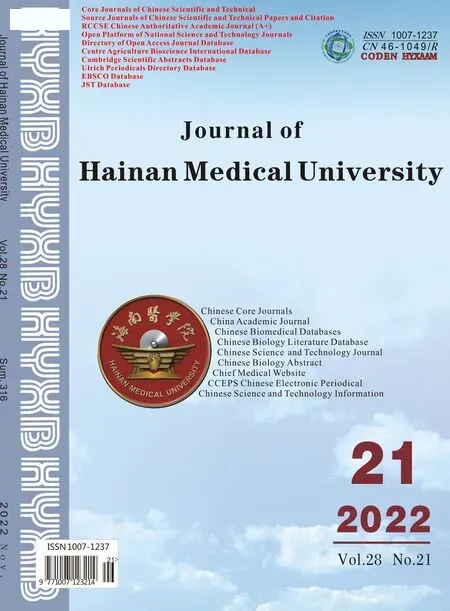Mechanism of Gan Dou Ling in improving liver fibrosis in Wilson disease based on network pharmacology and experimental verification
2022-02-04LIXiaoyunWANGHanSUNLantingLIXiangJIANGHailingHEWangshengYANGWenmingHUADaiping
LI Xiao-yun, WANG Han, SUN Lan-ting, LI Xiang, JIANG Hai-ling, HE Wang-sheng,YANG Wen-ming,3, HUA Dai-ping
1. Graduate school, Anhui University of Chinese Medicine, Hefei 230031, China
2. The First Affiliated Hospital of Anhui University of Chinese Medicine, Hefei 230031, China
3. Key Laboratory of Xin'an Medicine, Ministry of Education, Hefei 230031, China
Keywords:
ABSTRACT
1. Introduction
Wilson disease (WD) is an autosomal recessive disorder of copper metabolism caused by ATP7B gene mutation[1]. The clinical symptoms of WD caused by copper deposition are heterogeneous,mainly including liver and nervous system[2]. Almost all patients have different degrees of chronic liver injury and liver fibrosis. If the treatment is not timely, it will develop into cirrhosis. The latest research found that[3] penicillamine, a drug commonly used in clinic in patients with liver phenotype, can inhibit the immune system and increase the risk of infection. Therefore, more applicable treatment methods still need to be explored.
Gan Dou Ling is an in-hospital preparation of the First Affiliated Hospital of Anhui University of traditional Chinese medicine. It has been used in clinical practice for more than 30 years. It is composed of Radix Rhei Et Rhizome, Radix Salviae, Curcumae Rhizoma,Curcumaelongae Rhizoma, Spatholobus Suberectus and Coptidis Rhizoma. It has the effects of detoxifying and removing blood stasis, clearing heat and gall. Clinical studies have found that[4-6]Gan Dou Ling can significantly improve liver fibrosis, liver function and coagulation indexes in patients with WD, and play a role in eliminating copper and protecting the liver. Animal experiments have found that[7,8] Gan Dou Ling can significantly improve the degree of liver fibrosis in copper loaded rats. Its mechanism may be to reduce TGF by inhibiting Notch signal pathway in liver tissue of copper loaded rats- β 1. The expression level of PDGF.
As a new artificial intelligence interactive research method in the era of big data, network pharmacology integrates a large amount of clinical and experimental data, which is diverse and cuttingedge[9]. In this paper, the potential targets and mechanisms of Gan Dou Ling in the treatment of WD liver fibrosis were predicted by using the network pharmacology method, and the C57 Mouse Liver Fibrosis Model Induced by copper sulfate was verified by in vivo experiments, which provided a new idea for the further study of the potential targets of Gan Dou Ling in the treatment of WD liver fibrosis in the future.
2. Data and methods
2.1 Flexible components and target acquisition of Gan Dou Ling
At tcmsp( https://tcmsp-e.com/ )Search the active ingredient data of Radix Rhei Et Rhizome, Radix Salviae, Curcumae Rhizoma,Curcumaelongae Rhizoma, Spatholobus Suberectus and Rhizoma Coptidis, screen them with oral availability (OB) 30% and drug like (DL) 0.18, and obtain the corresponding active target in TCMSP database, remove the active ingredient without corresponding target, and use the protein database UniProt( https://www.uniprot.org/ )The target information is converted into human gene standardization to obtain the corresponding target gene.
2.2 WD liver fibrosis related gene data screening
Take "Wilson disease", "Wilson's disease" and "liver fibrosis" as keywords to search Genecards database(https://www.genecards.org/),DrugBank(https://go.drugbank.com/), PharmGKB database(https://www.pharmgkb.org/)DisGeNET database(https://www.disgenet.org/home/).
2.3 Acquisition of potential targets of Gan Dou Ling for prevention and treatment of WD hepatic fibrosis
Import the screened target data of Gan Dou Ling flexibility components, WD gene data and liver fibrosis gene data into the website for obtaining Wayne diagram[10](http://jvenn.toulouse.inra.fr/app/index.html)And get the intersection gene data.
2.4 PPI network analysis of intersection gene of Gan Dou Ling in prevention and treatment of WD liver fibrosis
Using the STRING web site(https://cn.string-db.org/)Analyze the correlation degree of protein-protein interaction between drug and disease intersection genes, select the highly correlated interaction score (0.7), and hide the non interaction nodes. Export the analyzed data to cytoscape3.8.2 software for protein-protein interaction network analysis (PPI), and get the top ten genes according to the degree value of protein-protein interaction correlation.
2.5 Enrichment analysis of intersection genes
The 108 drugs and disease intersection genes screened above were introduced into R version 4.1.2. The go database and KEGG database were downloaded with R package for enrichment analysis of the intersection gene between Gan Dou Ling and disease, and the histogram was drawn. Go analysis is divided into molecular function, biological process and cell component analysis. In order to simplify the data, go enrichment analysis results are sorted according to the number of genes after taking the top 20 as the p value, and KEGG enrichment analysis results are sorted according to the top 20 as the number of genes, and the histogram is drawn.
2.6 Experimental verification
2.6.1 Experimental animals
Sixty SPF grade C57 male mice, weighing (25 ± 5) g, were purchased from Hangzhou Medical College with certificate No.:scxk (Zhejiang) 2019-0002. They were raised in the animal room of the First Affiliated Hospital of Anhui University of traditional Chinese medicine. The temperature was (21 ± 2) ℃, the humidity was 50% ± 5%, the natural circadian rhythm, free to eat and drink.This experiment was conducted in accordance with the national regulations on the administration of experimental animals.
2.6.2 Drugs
Gan Dou Ling tablet, the First Affiliated Hospital of Anhui University of traditional Chinese medicine (wyzz z20050071);Penicillamine tablets, Shanghai Shangyao Xinyi Pharmaceutical Co.,Ltd. (gyzz No. h31022286); Copper sulfate pentahydrate (Sinopharm Chemical Reagent Co., Ltd., batch No. 20201105); High copper feed(Hefei Qingyuan Biotechnology Co., Ltd., batch No. 20210516).
2.6.3 Reagents and instruments
Main reagent: Goat anti mouse β- Actin (batch No.: 19aw0505),Goat anti mouse IgG (batch No.: 142637), Goat anti rabbit IgG(batch No.: 139931), manufacturer ZS bio; P-c-jun (batch No.:37j3230), p38 (batch No.: 10y0837), p-p38 (batch No.: 79d6101),JNK (batch No.: 51n7087), p-JNK (batch No.: 36c5455),manufacturer affinity;Main instruments: electrophoresis apparatus,electrophoresis tank, and rotating film apparatus (Shanghai Tianneng Technology Co., Ltd.); Normal temperature micro centrifuge(Haimen qilinbeier Instrument Manufacturing Co., Ltd.); High speed refrigerated centrifuge (Anhui Jiawen Instrument Equipment Co.,Ltd.); Micropipette (Eppendorf, Germany); Automatic exposure apparatus (Shanghai Peiqing Technology Co., Ltd.).
2.6.4 Grouping and administration method
The mice were randomly divided into blank group, model group,Gan Dou Ling low dose group, middle dose group, high dose group and penicillamine group. With reference to literature[8], mice were fed with a diet containing 1.5 g/kg copper sulfate and 0.185%copper sulfate deionized water for 24 weeks. At the 12 th week, the dosage group was converted to 9 times of the daily dosage of 70kg body weight adults, the high, medium and low dosage groups of Gan Dou Ling were 1.16 g/kg·d, 0.58 g/kg·d and 0.29 g/kg·d, and the penicillamine group was 0.1 g/kg·d. The blank group was given normal saline of equal volume once a day for 12 weeks[11].
2.6.5 Liver histopathological examination
The liver tissue was sectioned, dehydrated, embedded and sealed.Masson staining was performed. The liver tissue structure and the degree of liver fibrosis were observed under the optical microscope.
2.6.6 Western blot was used to detect the expression of related proteins in liver tissue
Weigh 70 mg of liver tissue of mice in each group, extract the total protein, and process the sample after electrophoresis to fully denature the protein. After sample loading, electrophoresis,membrane transfer and sealing, add p38 (1:1000), JNK (1:1000),c-jun (1:1000), p-p38 (1:1000) and p-JNK (1:1000) primary antibodies respectively, incubate overnight at 4 ℃, add washing solution (PBST), wash for 10 minutes each time, and wash 3 times in total. Incubate the secondary antibody at room temperature(1:10000) for 2 hours, add the washing solution (PBST), wash it three times for 10 minutes each time, detect the protein in the dark room, and analyze the film bands with Image J 1.8.0.112 software to β- Actin was used as internal parameter to calculate the relative expression of each protein.
2.7 Statistical methods
SPSS 26.0 software was used for data analysis. The measurement data were expressed in(x±s). one way ANOVA was used for multi group comparison. S-n-k test was used for pairwise comparison. If it did not conform to the normal distribution, the rank sum test was used. p<0.05 was statistically significant.
3. Result
3.1 Main active components and targets of Gan Dou Ling
The active ingredients of traditional Chinese medicine were integrated and sorted according to ob value, ranking among the top 20 active ingredients (Tab 1). As shown in the figure, the active components of Gan Dou Ling are: Przewalskin b, Corchoroside A_qt, Moupinamide, Aloe-emodin, Bisdemethoxycurcumin, Vestitol,Formyltanshinone, Miltionone Ⅱ, 8-o-Methylreyusi, Psi-Baptigenin,Formononetin, Epidanshenspiroketallactone, Palmatine.
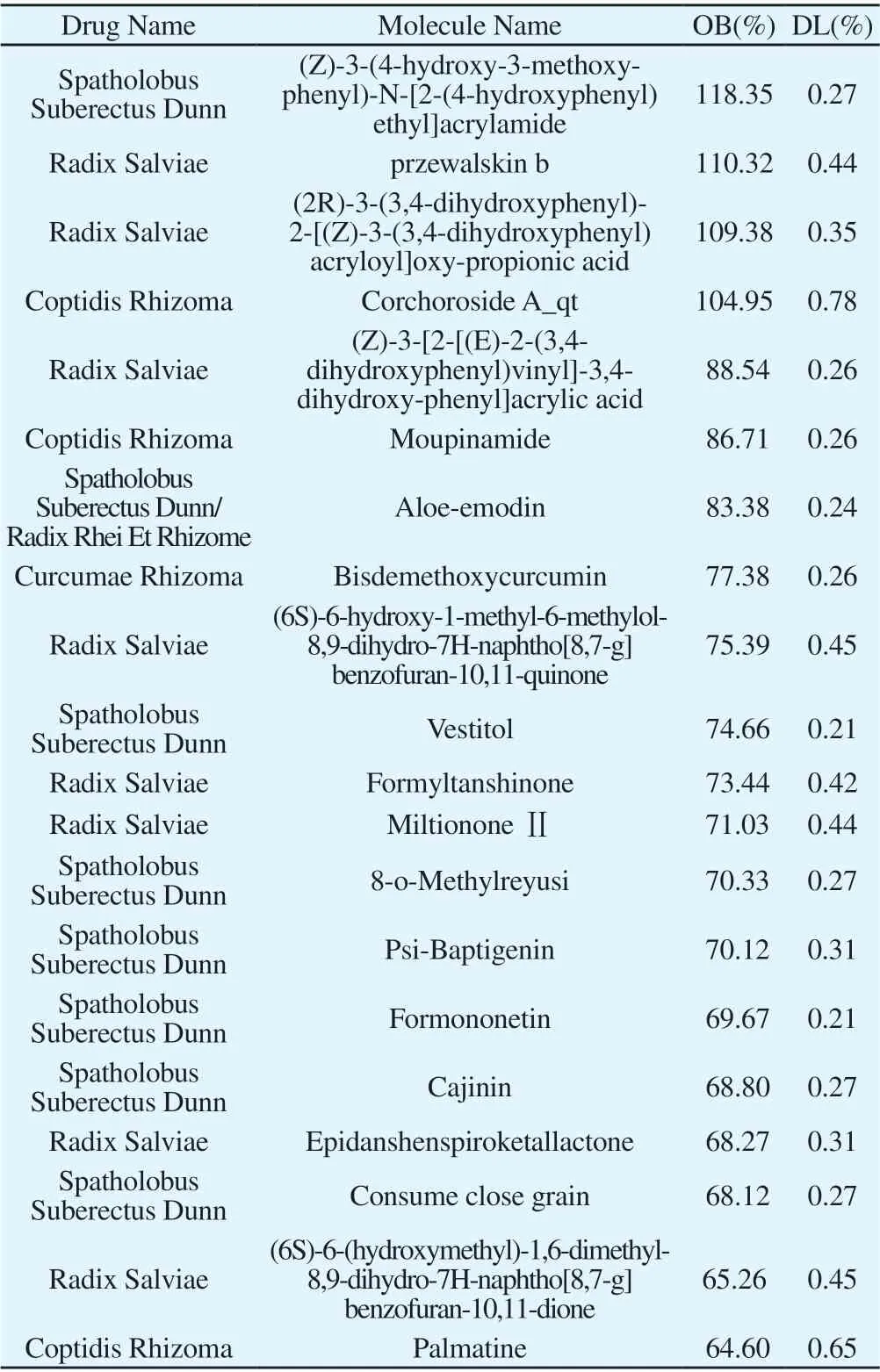
Tab1 Drug active components with OB value ranking top 20 in Gan Dou Ling
3.2 Potential therapeutic targets of Gan Dou Ling in prevention and treatment of WD hepatic fibrosis
As there were too many gene data, screening was carried out based on the condition that the correlation score was >9.800 144 196, and all genes were combined. Finally, 1287 WD closely related genes and 2 144 liver fibrosis closely related genes were sorted out. Import data into the jvenn website(http://jvenn.toulouse.inra.fr/app/index.html) 108 drug disease intersection genes were obtained.
3.3 Construction of PPI network and core gene of Gan Dou Ling for prevention and treatment of WD hepatic fibrosis
The intersection genes were introduced into the string website for PPI analysis and plotted with cytoscape3.8.2 (Fig. 1),
The top ten genes were ranked according to the degree value (Fig.2).
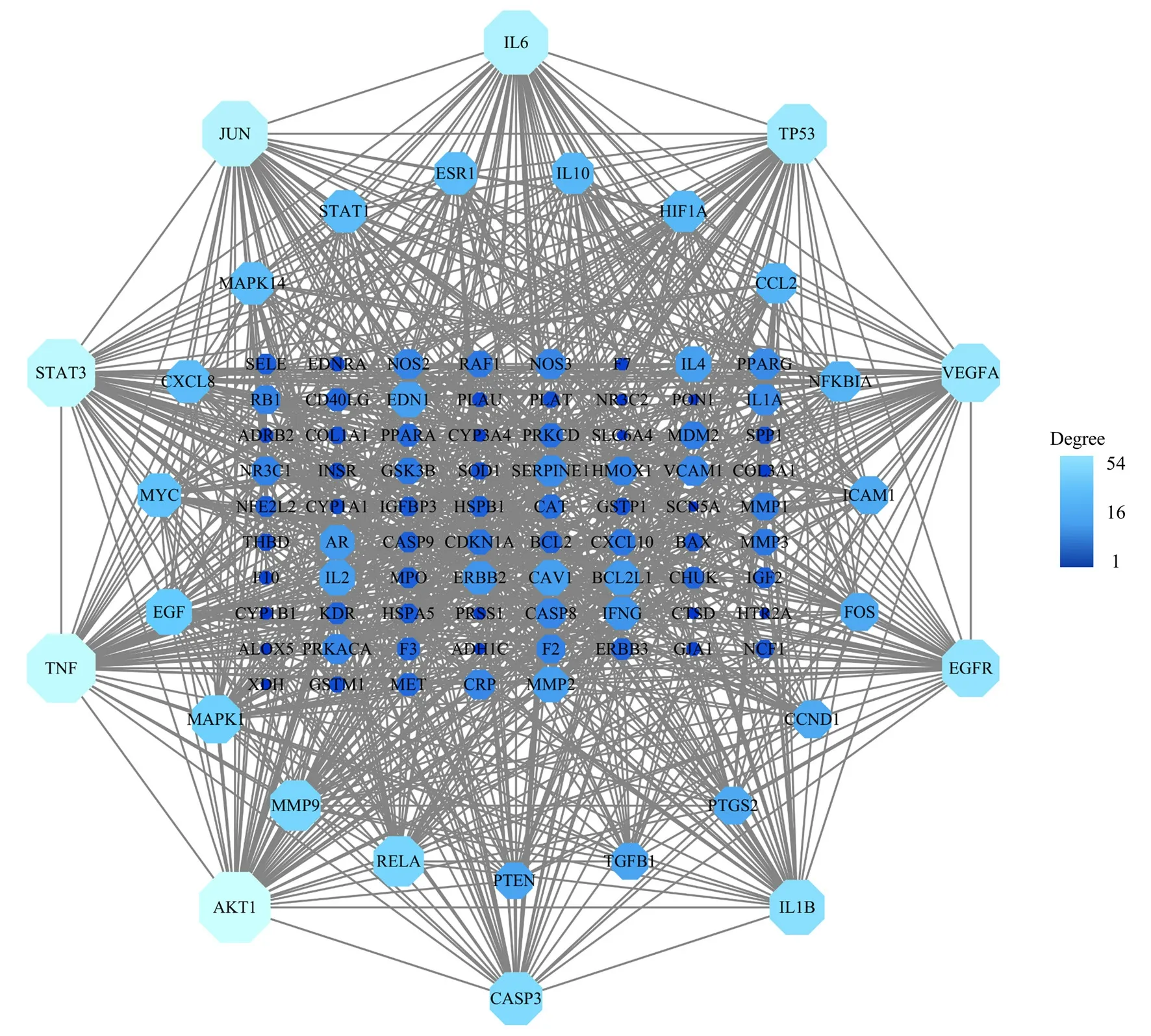
Fig1 PPI network of intersection gene of Gan Dou Ling in prevention and treatment of WD liver fibrosis
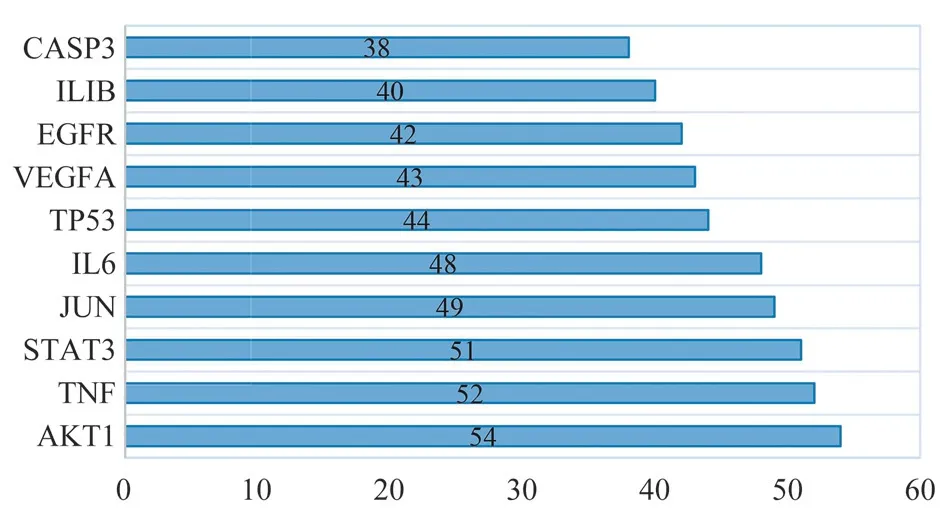
Fig2 The degree value of Gan Dou Ling in the prevention and treatment of WD liver fibrosis ranked among the top ten genes
AKT1, TNF, STAT3, JUN, IL6, TP53, VEGFA, EGFR, IL1B,CASP3 are the key target gene in the process of WD liver fibrosis.
3.4 Analysis results of intersection gene enrichment
The results of go enrichment analysis showed that Gan Dou Ling mainly through the biological process of wound healing, response to oxidative stress, response to xenobiotic stimulus; membrane microdomain, membrane raft, vesicle lumen in cell components;signaling receptor activator activity, receptor ligand activity,D-binding transcription factor binding in molecular function plays a role in the course of WD hepatic fibrosis.
The results of KEGG pathway enrichment analysis show that Gan Dou Ling mainly acts on MAPK signaling pathway, AGERAGE signaling pathway in diabetic complications, Lipid and atherosclerosis in the process of WD liver fibrosis (Fig. 3).
3.5 Animal experiment verification
3.5.1 Comparison of liver histopathology of mice in each groupThe results of HE staining of liver tissue showed that the cell structure of liver tissue in the blank group was complete, the nucleus was round and centered, and there was no aggregation of inflammatory cells. Compared with the model group, the liver tissue structure of the treatment group was improved in varying degrees: the structure of hepatic cord and hepatic lobule was destroyed, the number of hepatocyte necrosis and nuclear pyknosis and hyperchromatism decreased, and the improvement was more obvious in the high-dose Gan Dou Ling group in the traditional Chinese medicine group. Masson staining showed that the amount of blue staining of collagen fibers around the portal area in each treatment group was significantly lower than that in the model group.In the model group, the structure of hepatic lobules was disordered,the short fibrous septum around the central vein was formed, and the focal inflammatory cells were aggregated (Fig. 4).

Fig3 Enrichment analysis results of GO and KEGG in prevention and treatment of WD hepatic fibrosis with Gan Dou Ling

Fig4 Effect of Gan Dou Ling on liver histopathology of copper loaded mice (200×)
3.5.2 Comparison of p38, p-p38, JNK, p-JNK and p-c-jun protein expression in liver tissues of mice in each group
Western blot results showed that there was no significant difference in the expression of p38 and JNK in the liver tissues of mice in each group, and the expression of p-p38, p-JNK and p-c-jun was significantly inhibited in the Gan Dou Ling 1890 medium dosegroup, Gan Dou Ling high dose group and penicillamine group(P<0.0001) (Fig. 5 and Tab 2).

Tab2 Comparison of P38,p-P38,JNK,p-JNK,p-C-JUN protein expression in liver tissue of mice in each group (n=3, x±s)
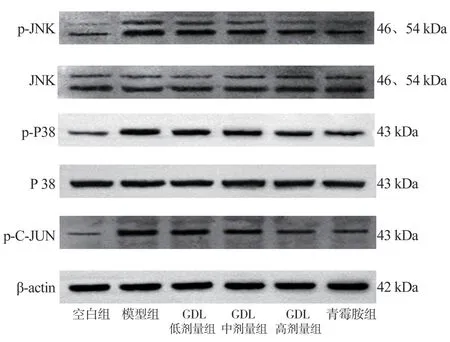
Fig5 Comparison of P38、p-P38、JNK、p-JNK、p-C-JUN protein expression in liver tissue of mice in each group
4. Discuss
Although copper is an essential trace element in human body, its accumulation will produce high toxicity in case of excessive intake or metabolic disorder[12]. WD is a genetic disease of liver copper metabolism disorder caused by ATP7B gene mutation. As the first affected organ of copper metabolism disorder, excessive copper can directly damage the structural components in hepatocytes, destroy the redox balance, cause inflammatory reaction and then cause liver fibrosis[13]. Liver disease is the first clinical manifestation of about 40%-60% of WD patients[14]. There is no relevant record of WD disease name in traditional Chinese medicine. According to its clinical symptoms, it can be classified into "liver wind","accumulation" and other categories. The key to the pathogenesis of WD is the accumulation of copper toxin and the obstruction of collaterals by phlegm and blood stasis. The accumulation of copper toxin hinders the Qi mechanism, hinders the excretion of bile, and the loss of liver discharge is "liver wind". The clinical manifestations are tremor, psychoneurological symptoms, etc. The combination of phlegm dampness and blood stasis leads to "accumulation". The clinical manifestations are hepatosplenomegaly, hypersplenism, and even cirrhosis.
In this study, 119 hepatolentil flexibility components and 108 hepatolentil WD liver fibrosis intersection genes were obtained by integrating and analyzing the data of various platforms. According to previous data, Aloe-emodin can improve liver function and reduce inflammatory infiltration in the core active ingredients of Gan Dou Ling[15]; Bisdemethoxycurcumin can protect the liver through anti-inflammatory and anti-oxidation[16]; Formononetin has antiinflammatory and anti-virus effects[17]; Palmatine can improve liver injury, reduce inflammation and inhibit fibrosis process by activating autophagic protective mechanism[18, 19]. It is suggested that most of the effective components of Gan Dou Ling can improve the liver fibrosis in WD through anti-inflammatory and anti-oxidation. In the core gene of Gan Dou Ling for the treatment of WD liver fibrosis,AKT1 can mediate the production of reactive oxygen species and stimulate liver fibrosis[20]; TNF, IL-6, IL-1 β Both are inflammatory factor genes, which promote the progress of liver fibrosis[21]; STAT3 participates in the process of fibrosis by increasing extracellular matrix[22]; Jun is an important regulator of hepatocyte survival in endoplasmic reticulum stress. It is reported that overexpression of Jun will promote liver fibrosis[23]. According to the results of core gene analysis and KEGG enrichment analysis, MAPK signal pathway with high correlation was selected as the research target of Gan Dou Ling in the prevention and treatment of WD liver fibrosis. MAPK is a signal pathway based on phosphorylation and characterized by cascade amplification. This pathway is widely expressed in human body and is closely related to immune related diseases, the occurrence and development of tumors, tissue and organ fibrosis and so on. The p38 MAPK pathway, c-Jun N-terminal kinase (JNK) pathway and extracellular signal regulated kinases(ERKs) pathway in eukaryotic cells are three classical MAPK signaling pathways. P38 MAPK pathway plays an important role in stress responses such as inflammation and programmed cell death[24]; JNK signaling is related to cell death, survival,differentiation, proliferation and tumorigenesis in hepatocytes.In addition, it is involved in inflammation and fibrosis[25]. In the mouse model of liver fibrosis, the activation of p38 MAPK and JNK signaling pathways increased[26,27], and inhibition of p38/JNK signaling pathway can reduce the process of liver fibrosis.
The results of animal experiments showed that the long-term overload of copper in mouse liver could cause liver fibrosis, and p38/JNK signal pathway was activated during this course. Compared with the model group, the p38/JNK signal pathway in the liver tissue of mice fed with traditional Chinese medicine was inhibited,especially in the high-dose Gan Dou Ling group, suggesting that Gan Dou Ling may inhibit the process of WD liver fibrosis by inhibiting the activation of MAPK signal pathway and reducing the expression of pathway related proteins. However, the specific mechanism of action is not clear, which needs further exploration and research.
In conclusion, this study analyzed the possible molecular mechanism of Gan Dou Ling in preventing and treating WD liver fibrosis through network pharmacology, and verified that Gan Dou Ling may play a role in treating WD liver fibrosis by inhibiting the activation of p38/JNK signal pathway and reducing the expression of pathway related proteins through copper loaded mouse experiment.This experiment provides a reference for further study on the basic analysis of the effective components and the molecular mechanism of action of Gan Dou Ling, and also makes the future related research more targeted.
Conflict of interest statement: none.
杂志排行
Journal of Hainan Medical College的其它文章
- Research progress on depression models of different strains of rats and mice
- Study on TCM intervention of NF-κB signal pathway in the treatment of bronchial asthma
- Meta-analysis of the clinical efficacy of Liqi Huoxue drop pill in the treatment of angina pectoris in coronary artery disease
- Systematic review and meta-analysis on efficacy of traditional Chinese medicine in treatment of inflammatory factors in patients with poststroke depression
- Screening and comprehensive analysis of key genes in liver hepatocellular carcinoma based on bioinformatics
- Design and characterization of a bi-functional bybrid antibacterial peptide LLM against Pseudomonas aeruginosa
